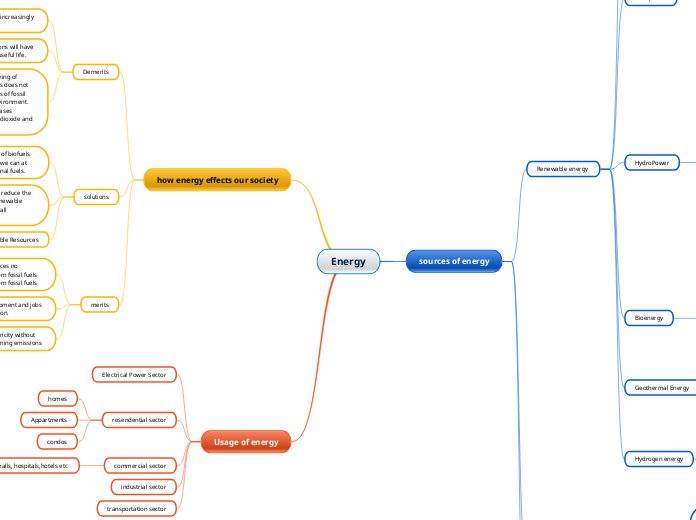
Renewable energy
Solar Energy
Solar energy can be harnessed in a variety
of ways to heat homes, heat water, grow
plants and produce electricity
components
solar panels,
inverter
electrical panel
electrical meter
the sun
wind power
Wind energy is a clean renewable energy
source produced by the daily cooling and
heating patterns on the surface of the
earth.
Types
Utility-Scale Wind.
Utility-scale wind turbines are mounted on towers, some 300 feet or taller.
Offshore Wind.
The force of the winds out at sea, transformed into electricity
Distributed or “Small” Wind”
Often smaller generation units that are located on the consumer's side of the meter
HydroPower
An impoundment facility, typically a large hydropower system, uses a dam to store river water in a reservoir. Water released from the reservoir flows through a turbine, spinning it, which in turn activates a generator to produce electricity.
Types of dams
impoundment dam
artificially created standing waterbodies, produced by dams on streams or rivers.
storage dam
constructed to store water during the rainy seasons, supply water to the local wildlife, and store water for hydroelectric power generation, and irrigation.
run the river dam
hydroelectric systems that harvest the energy from flowing water to generate electricity in the absence of a large dam and reservoir
parts of dams
crest
The crest is the top part of a Dam, used for providing a walkway above.
heel
The heel is the part that touches the ground on the upstream side of a dam.
toe
Like the heel, the toe is a structure that remains in contact with the river-bed on a downstream slope.
parapet walls
Parapet walls are the less protecting walls on each side of the roadway or walkway of the crest.
Bioenergy
Biomass energy or bioenergy is the energy
from organic matter such as fire wood,
twigs, dead plant parts, cattle dung,
livestock manure and dead animal matter
components
hemicellulose
cellulose
lignin
Geothermal Energy
Geothermal energy refers to energy
contained in underground rock and fluids.
Thermal or heat energy deep within the
earth may heat water or form steam.
Geothermal plants
Direct Dry Steam
Flash and Double Flash Cycle
Binary Cycle.
Hydrogen energy
Hydrogen fuel cells produce electricity by combining hydrogen and oxygen atoms. The hydrogen reacts with oxygen across an electrochemical cell similar to that of a battery to produce electricity, water, and small amounts of heat
Uses
1. fuel
2. industrial energy
key elements
production, packaging, transport, storage and transfer of pure hydrogen
Non renewable enerfy
coal
Coal is the most common solid fossil fuel
which was used as a primary source of
energy in homes and industry. It is found
under the ground in solid form and have to
be mined and transported for use
Oil
Oil is a liquid fossil fuel that is found under
the ground and below the sea floor
Natural gas
Natural gas is also fossil fuel that is a
mixture of gases found under the ground
Nuclear Energy
Nuclear energy is liberated from a nuclear
reaction, fission or fusion, or by radioactive
decay. It produces highly radioactive
materials that must be kept safely for
thousands of years until their radioactivity
falls to safe levels.
Demerits
Petroleum will become increasingly
expensive and scarce.
Current nuclear installations will have
reached the end of their useful life.
Energy is produced by the burning of
non-renewable fossil fuels. This does not
only affect the global resources of fossil
fuels, but it also affects the environment.
The burning of fossil fuels releases
greenhouse gases like carbon dioxide and
others.
solutions
A possible alternative is the use of biofuels
like bioethanol and biodiesel so we can at
least partially replace conventional fuels.
The best possible solution is to reduce the
world’s dependence on non-renewable
resources and to improve overall
conservation efforts.
Move Towards Renewable Resources
merits
Generating energy that produces no
greenhouse gas emissions from fossil fuels
greenhouse gas emissions from fossil fuels
Creating economic development and jobs
in manufacturing, installation.
Wind power generates electricity without
toxic pollution or global warming emissions
Electrical Power Sector
resendential sector
homes
Appartments
condos
commercial sector
offices, malls, hospitals,hotels etc
industrial sector
transportation sector